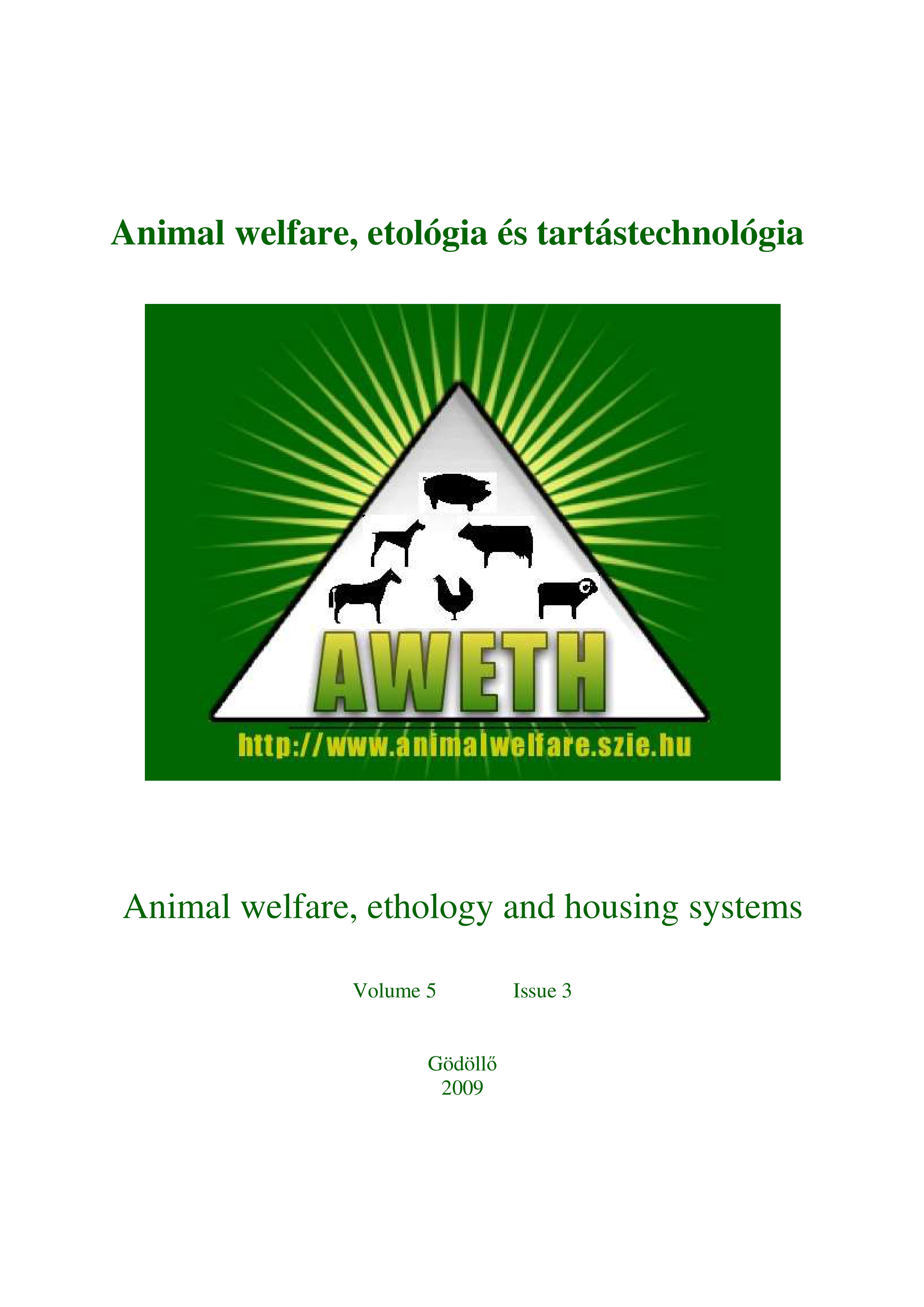The behaviour of cows in response to rubber mats in milking parlour stalls
Abstract
Lameness in cattle is a major health problem, because the disease causes substantial pain and discomfort and lasts for a lengthy amount of time. One of the ways to give cows more relief from hard surface is allowing them to walk on the softer flooring. This kind of surface is commonly used in the cubicles and walkways. Cows spend a relatively long time in the milking parlour and are at risk of damaging their hooves by contact to hard and slippery surfaces. Introducing rubber mats in the milking parlour is integration in the environment which is well known to animals. As a reaction to a novel object this can cause a disturbance of every day habits. Rubber mats, as a softer surface can cause a competition for a desired resource and then increase of aggressive behaviours within the animal. The objective of this research was to evaluate cows’ response to rubber mats introduced in the milking parlour stalls. The observation was focused on measuring the changes in time taken to fill parlour stalls. Saving in time was predicted to be the main benefit of introducing the mats, the second measurement estimated changes in aggressive behaviour. The ethogram included the observation of pushing and head butting was performed to estimate the occurrence of aggressive behaviours in the waiting area just before entering the stalls. Results from this study provide evidence to suggest that introducing the rubber mats decreased time taken to fill parlour stalls. There was a very significant decrease in the time taken to fill those stalls with mats than the stalls without rubber mats present. The difference in time required to fill parlour stalls between the last and the first week of the research indicated a saving in time of 40.33 (confidence limits 31.31 - 49.34) seconds per milking. There was no significant difference in occurring pushes and head butts between sides with rubber mats and without rubber mats, however, there was an increase in aggressive behaviour during the study. In conclusion, it is presumed that due to the rubber flooring cows were more excited and motivated to fill parlour stalls quicker whether mats were present or not. Using the rubber mats is a benefit in saving time and giving relief to cows’ hooves without compromising animal welfare.
References
Alvey, N. and Galwey, N. (1982): An Introduction to Genstat. London: Academic Press Inc, 82.
Blowey, R.W. and Weaver, A.D. (2003): Color Atlas of Diseases and Disorders of Cattle. Edinburgh: Elsevier Health Sciences. https://doi.org/10.1016/B978-0-7234-3205-0.X5001-5
Bouissou, M. F., Boissy, A., Le Neindre, P., Veissier, I. (2001): The social behaviour of cattle. In: Keeling, L.J., Gonyou, H.W. (Eds.): Social Behaviour in Farm Animals., Wallingford: CAB International, 113–145. https://doi.org/10.1079/9780851993973.0113
Enting, H., Kooij, D., Dijkhuizen, A.A., Huirne, R.B.M. and Noordhuizen-Stassen, E.N. (1997): Economic losses due to clinical lameness in dairy cattle. Livestock Production Science, 49(3) 259–267. https://doi.org/10.1016/S0301-6226(97)00051-1
Esslemont, R.J. and Kossaibati, M.A. (1996): Incidence of production diseases and other health problems in a group of dairy herds in England. The Veterinary Record, 139(20) 486–490. https://doi.org/10.1136/vr.139.20.486
DeVries, T.J., von Keyserlingk, M.A.G. and Weary, D.M. (2004): Effect of Feeding Space on the Inter-Cow Distance, Aggression, and Feeding Behavior of Free-Stall Housed Lactating Dairy Cows. Journal of Dairy Science, 87(5) 1432–1438. https://doi.org/10.3168/jds.S0022-0302(04)73293-2
Fregonesi, J.A. and Leaver, J.D. (2002): Influence of space allowance and milk yield level on behaviour, performance and health of dairy cows housed in straw yard and cubicle systems. Livestock Production Science, 78(3) 245–257. https://doi.org/10.1016/S0301-6226(02)00097-0
Gygax, L., Neuffer, I., Kaufmann, C., Hauser, R. (2008): Restlessness behaviour, heart rate and heart-rate variability of dairy cows milked in two types of automatic milking systems and auto-tandem milking parlours. Applied Animal Behaviour Science, 109(2–4) 167–179. https://doi.org/10.1016/j.applanim.2007.03.010
Irps, H. (1983): Results of research projects into flooring preferences of cattle. In: Baxter, S.H., Baxter, M.R. and MacCormack, J.A.C. Editors, Farm Animal Housing and Welfare. Seminar in the Commission of the European Communities Programme of Coordination of Research on Animal Welfare, Martinus Nijhoff Publishers, The Hague (1983): 200–215. In Boyle, L.A., Mee, J.F., Kiernan, P.J. (2007): The effect of rubber versus concrete passageways in cubicle housing on claw health and reproduction of pluriparous dairy cows. Applied Animal Behaviour Science, 106. 1–12.
Manske, T., Hultgren, J., Bergsten, C. (2002): A cross-sectional study of risk factors for the hoof health of Swedish dairy cows. Swedish University of Agricultural Sciences – Thesis. Acta Universitatis Agriculturae Sueciae Veterinaria, 138.
Payne, R. (2005): The Guide to GenStat® Release 8 Part 2: Statistics. Oxford: VSN International, 997.
Telezhenko, E., Lidfors, L. and Bergsten, C. (2004): Preferences of dairy cows for walking and standing on different floors. Proceedings of the 38th International Congress of the International Society for Applied Ethology, Helsinki, 120.
Telezhenko, E., Lidfors, L. and Bergsten, C. (2007): Dairy Cow Preferences for Soft or Hard Flooring when Standing or Walking. Journal of Dairy Science, 90(8) 3716–3724. https://doi.org/10.3168/jds.2006-876
Van Der Tol, P.P.J., Metz, J.H.M., Noordhuizen-Stassen, E.N., Back, W., Braam, C.R. and Weijs, W.A. (2005): Frictional forces required for unrestrained locomotion in dairy cattle. Journal of Dairy Science, 88(2) 615–624. https://doi.org/10.3168/jds.S0022-0302(05)72725-9
Vanegas, J., Overton, M., Berry, S.L. and Sischo, W.M. (2006): Effect of Rubber Flooring on Claw Health in Lactating Dairy Cows Housed in Free-Stall Barns. Journal of Dairy Science, 89(11) 4251–4258. https://doi.org/10.3168/jds.S0022-0302(06)72471-7
Vermunt, J. J. and Greenough, P. R. (1994): Predisposing factors of laminitis in cattle. The British Veterinary Journal, 150(2) 151–164. https://doi.org/10.1016/S0007-1935(05)80223-4
Watson, C. (2007): Lameness in Cattle: Floor Properties. London, The Crowood Press Ltd.
Downloads
Published
Issue
Section
License
Copyright (c) 2009 Richard Gudaj

This work is licensed under a Creative Commons Attribution-NonCommercial-NoDerivatives 4.0 International License.
The journal operates according to the principles of open access, however, the content is available under the Creative Commons 4.0 standard licenc: CC-BY-NC-ND-4.0. Under the following terms: You must give appropriate credit, provide a link to the license, and indicate if changes were made. You may do so in any reasonable manner, but not in any way that suggests the licensor endorses you or your use. You may not use the material for commercial purposes. If you remix, transform, or build upon the material, you may not distribute the modified material. You may not apply legal terms or technological measures that legally restrict others from doing anything the license permits.














